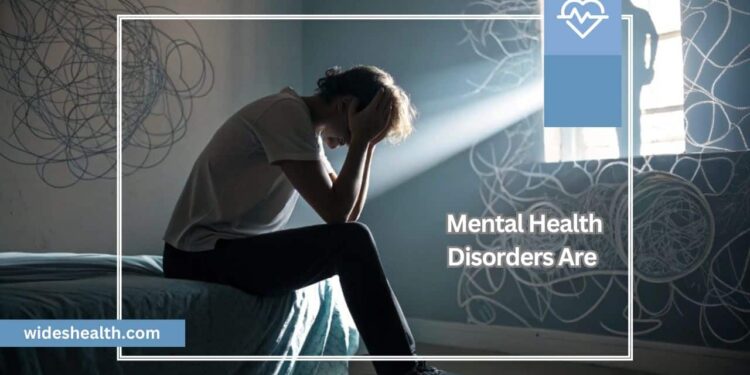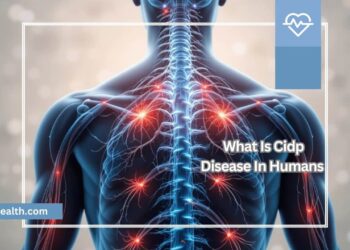Mental health disorders affect millions of people worldwide, with 1 in 8 individuals experiencing some form of mental illness. These disorders involve significant disturbances in thinking, emotional regulation, or behavior, often leading to distress and impaired daily functioning.
Despite the availability of effective treatment options, many people lack access to proper care due to stigma, discrimination, and healthcare system limitations. This article explores different types of mental disorders, their symptoms, causes, and treatment options while highlighting the importance of mental health awareness and early intervention.
What Are Mental Health Disorders?
A mental health disorder is a clinically significant condition that affects an individual’s cognition, emotions, or behavior, leading to difficulties in social, occupational, and personal life. These disorders can be short-term or chronic and may range from mild to severe.
The World Health Organization (WHO) classifies mental health disorders under the International Classification of Diseases (ICD-11), recognizing various conditions, including anxiety disorders, depression, bipolar disorder, schizophrenia, PTSD, eating disorders, and neurodevelopmental disorders.
Key Statistics on Mental Health Disorders:
- 970 million people worldwide had a mental disorder in 2019.
- Anxiety and depression are the most common mental disorders.
- The COVID-19 pandemic caused a 26-28% increase in anxiety and depressive disorders.
- Schizophrenia affects 24 million people, reducing life expectancy by 10-20 years.
- Only 29% of people with psychosis and one-third of people with depression receive formal treatment.
Understanding Mental Health Disorders:
More Than a Definition:
Mental health disorders involve serious disruptions in thoughts, emotions, and behavior. They affect one in eight people worldwide, making daily life difficult. These disorders include anxiety, depression, bipolar disorder, PTSD, and schizophrenia. Unlike temporary stress or sadness, they persist and require treatment. Acknowledging them as real medical conditions helps reduce stigma and encourage people to seek help.
The Stigma Surrounding Mental Health:
Society often views mental illness as a weakness, leading to misconceptions. Many believe depression is laziness or anxiety is overthinking. This stigma prevents people from seeking help, and fearing judgment. Educating people, promoting open conversations, and challenging stereotypes can create a more understanding society where those struggling feel safe to ask for support.
Impact on Daily Life:
Mental disorders affect work, relationships, and overall well-being. Depression can drain motivation, while anxiety can make social interactions terrifying. Disorders like bipolar and schizophrenia cause mood swings and distorted perceptions. Without proper support, daily life becomes overwhelming. With therapy, medication, and community support, people can manage their conditions and lead fulfilling lives.
Personal Experience: Living with Anxiety and Depression!
Recognizing the First Signs:
I first noticed my anxiety and depression at 17 years old. Tasks I once enjoyed felt exhausting, and my mind constantly raced with worry. Simple things like sending a message or getting out of bed felt impossible. I didn’t realize it was more than stress until it started affecting my daily life and relationships.
The Darkest Moments:
Depression made me feel emotionally numb, and anxiety kept me in constant fear. I hid my struggles, pretending everything was fine, but inside, I felt lost. The hardest part was convincing myself I needed help. I feared being judged, but ignoring the problem only made it worse. Seeking support changed my perspective.
Finding Help and Healing:
Reaching out for help was the turning point. Therapy, journaling, and lifestyle changes helped me manage my emotions. Talking to someone who understood, learning coping techniques, and prioritizing self-care made a difference. Healing wasn’t instant, but I realized that asking for help is a sign of strength, not weakness.
Also read: What Is Cidp Disease In Humans – Symptoms, Causes & Treatment Guide!
The Global Impact of Mental Health Disorders:
Mental health disorders are a leading cause of disability worldwide. The COVID-19 pandemic worsened these issues, causing a sharp rise in anxiety and depression cases. Despite effective treatments, many lack access due to stigma, discrimination, and underfunded health systems.
Poor mental health also impacts productivity, relationships, and overall quality of life globally. Suicide rates have increased in many regions, highlighting the urgent need for mental health support. Greater investment in mental health care can save lives and improve societal well-being.
How to Support Someone with a Mental Health Disorder?
Understanding mental health conditions helps provide better support. Learn about symptoms, treatments, and challenges they face. Awareness reduces stigma and fosters empathy. Reading reliable sources, attending workshops, or speaking with professionals can improve your ability to help effectively. Knowledge empowers you to offer meaningful assistance without reinforcing misconceptions or stereotypes.
Listen Without Judgment:
Create a safe and supportive environment where they can openly express their feelings. Avoid dismissing their struggles or offering quick fixes. Sometimes, listening is more powerful than giving advice. Validate their emotions by acknowledging their pain and showing compassion. Let them know they are not alone and that their feelings are valid.
Encourage Professional Help:
Gently suggest seeking therapy or medication if needed. Mental health professionals provide guidance, coping strategies, and medical support. Offer to help find resources, accompany them to appointments, or research treatment options together. Avoid forcing decisions—encouragement should be supportive, not pressuring. Respect their choices while emphasizing the importance of seeking professional care.
Be Patient:
Recovery is a gradual process that requires understanding and time. Progress may be slow, with setbacks along the way. Avoid frustration or unrealistic expectations. Offer ongoing support through small gestures—checking in, spending time together, and reassuring them that they are valued. Patience fosters trust, helping them feel secure and supported.
Breaking the Cycle: How Society Can Help!
Encouraging Open Conversations:
Mental health should be as normal to discuss as physical health. Schools, workplaces, and communities must create safe spaces for people to talk about their struggles without fear. Social media, campaigns, and storytelling can help normalize these conversations and encourage people to seek support when needed.
Providing Better Mental Health Resources:
Access to affordable therapy, mental health education, and workplace support is crucial. Only 29% of people with psychosis and 33% of those with depression receive treatment. More funding for mental health programs, trained professionals, and crisis helplines can bridge the gap and ensure care for all.
Also read: Creekview Health And Rehab – A Place Of Healing And Comfort!
Supporting Loved Ones with Mental Health Struggles:
If someone you know is struggling, listen without judgment. Avoid phrases like “just be happy” and instead say, “I’m here for you.” Small actions, like checking in, offering help, and showing patience, can make a big difference. Encouraging therapy and providing emotional support helps them feel less alone.
What are the common causes of mental illness?
Mental illnesses develop due to a combination of biological, psychological, and environmental factors. Genetics plays a role, as individuals with a family history of mental illness may be more vulnerable. Imbalances in brain chemistry can contribute to conditions like depression and schizophrenia.
Traumatic experiences, such as abuse, loss of a loved one, or chronic stress, can trigger mental health issues. Social isolation, lack of support, and substance abuse are also major risk factors. Additionally, underlying physical health conditions, like chronic pain or hormonal imbalances, may impact mental well-being.
Types of Mental Health Disorders:
- Anxiety Disorders – Affect 301 million people; involve excessive fear, worry, and panic attacks (e.g., GAD, Social Anxiety, Panic Disorder). Treatment: CBT, medication, lifestyle changes.
- Depression – Impacts 280 million people; characterized by persistent sadness, hopelessness, and suicidal thoughts. Treatment: Therapy, antidepressants, and self-care strategies.
- Bipolar & Schizophrenia – Bipolar (40M) causes mood swings between depression & mania; Schizophrenia (24M) leads to hallucinations and delusions. Treatment: Mood stabilizers, antipsychotics, therapy.
- PTSD & Eating Disorders – PTSD results from trauma, causing flashbacks & anxiety; Eating Disorders (14M) include Anorexia & Bulimia, affecting body image & food habits. Treatment: Trauma therapy, nutritional counseling.
- Neurodevelopmental Disorders – Includes Autism (ASD), ADHD, and Intellectual Disabilities, affecting social, cognitive, and motor skills from childhood. Treatment: Behavioral therapy, speech therapy, medication.
Treatment Options for Mental Health Disorders:
Psychotherapy:
Therapy helps individuals manage mental health conditions. Cognitive Behavioral Therapy (CBT) identifies and changes negative thought patterns, improving emotional well-being. Dialectical Behavior Therapy (DBT) focuses on emotional regulation and coping skills, especially for those with mood disorders. Therapy provides structured support, helping individuals develop healthier thinking and behavior patterns for long-term recovery.
Medication:
Medication can help manage symptoms of mental health disorders. Antidepressants treat depression and anxiety, while antipsychotics help with schizophrenia and bipolar disorder. Mood stabilizers prevent extreme mood swings. While medication is effective, it works best alongside therapy. Proper medical guidance is necessary to adjust dosages and minimize side effects for optimal mental health management.
Lifestyle Changes:
Healthy habits improve mental health. Regular exercise reduces stress and boosts mood by releasing endorphins. A balanced diet supports brain function, while adequate sleep helps emotional regulation. Mindfulness practices like meditation and journaling reduce anxiety. Small lifestyle adjustments can greatly enhance mental well-being, complementing therapy and medication for a holistic recovery approach.
Support Systems:
Strong social support aids recovery. Family and friends provide emotional encouragement, reducing feelings of isolation. Support groups and peer communities offer shared experiences and guidance. Professional counseling also strengthens coping mechanisms. Having a reliable support system fosters resilience, helping individuals navigate challenges and maintain progress in their mental health journey.
How many mental disorders exist?
The number of recognized mental disorders continues to grow as research advances. The DSM-5 (Diagnostic and Statistical Manual of Mental Disorders) and ICD-11 (International Classification of Diseases) list over 200 mental health conditions.
Among these, the most well-known include 10 major types, such as anxiety disorders, depression, PTSD, schizophrenia, and personality disorders. Expanding further, there are over 20 broad categories, covering conditions like neurodevelopmental disorders, mood disorders, and trauma-related conditions. Mental health professionals use these classifications to diagnose and develop treatment plans for individuals struggling with various disorders.
How can mental health disorders be treated?
WHO’s Response to Mental Health Disorders
The World Health Organization (WHO) has implemented various initiatives to enhance mental healthcare worldwide. Key efforts include:
- Comprehensive Mental Health Action Plan (2013-2030) – A long-term strategy aimed at integrating mental health services into primary healthcare, promoting prevention, and ensuring access to quality care.
- Mental Health Gap Action Programme (mhGAP) – Focuses on training healthcare professionals, particularly in low-resource settings, to diagnose and manage mental health conditions effectively.
Challenges in Mental Health Care:
Despite global efforts, several challenges hinder mental health support:
- Stigma and Discrimination – Many individuals avoid seeking help due to societal misconceptions and fear of judgment.
- Limited Access to Treatment – Healthcare disparities lead to insufficient mental health services, especially in underserved regions.
- Lack of Awareness – Many communities have minimal understanding of mental health, preventing early intervention and support.
WHO continues to work towards reducing these barriers, promoting mental health education, and improving access to care worldwide.
FAQS:
1. How does mental health impact physical health?
Mental health affects physical well-being, leading to heart disease, weakened immunity, sleep disturbances, and fatigue. Chronic stress and anxiety increase inflammation, impacting overall health. Managing mental health improves energy, immunity, and reduces risks of serious illnesses.
2. Can mental health disorders be prevented?
While not always preventable, stress management, strong social connections, and healthy coping strategies can lower risks. Early intervention, self-care, and therapy help build resilience, reducing the likelihood of developing severe mental health disorders over time.
3. How do social relationships affect mental health?
Supportive relationships reduce stress, boost self-esteem, and provide emotional stability. Loneliness increases depression and anxiety risks, while toxic relationships worsen mental health. Prioritizing positive connections and community support significantly enhances overall emotional well-being and resilience.
4. What role does diet play in mental health?
A balanced diet rich in omega-3s, vitamins, and antioxidants supports brain function and mood regulation. Processed foods, excessive sugar, and caffeine can worsen anxiety and depression, while proper nutrition enhances mental clarity and emotional stability.
5. How can workplaces promote mental health?
Workplaces can support mental health by offering mental health resources, flexible schedules, and stress management programs. Open communication, supportive environments, and wellness initiatives help employees maintain well-being, reducing burnout and increasing productivity.
Conclusion:
Mental disorders affect millions globally, disrupting emotional, cognitive, and behavioral functions. Despite effective treatments, stigma, discrimination, and limited healthcare access prevent many from receiving proper care. The COVID-19 pandemic worsened mental health issues, increasing anxiety and depression rates significantly.
Addressing these challenges requires stronger healthcare systems, awareness campaigns, and accessible treatment options worldwide. Greater investment in mental health policies, early intervention, and community-based support can help reduce suffering and improve the quality of life for those struggling with mental disorders. Ending stigma and expanding resources is crucial for a healthier future.











